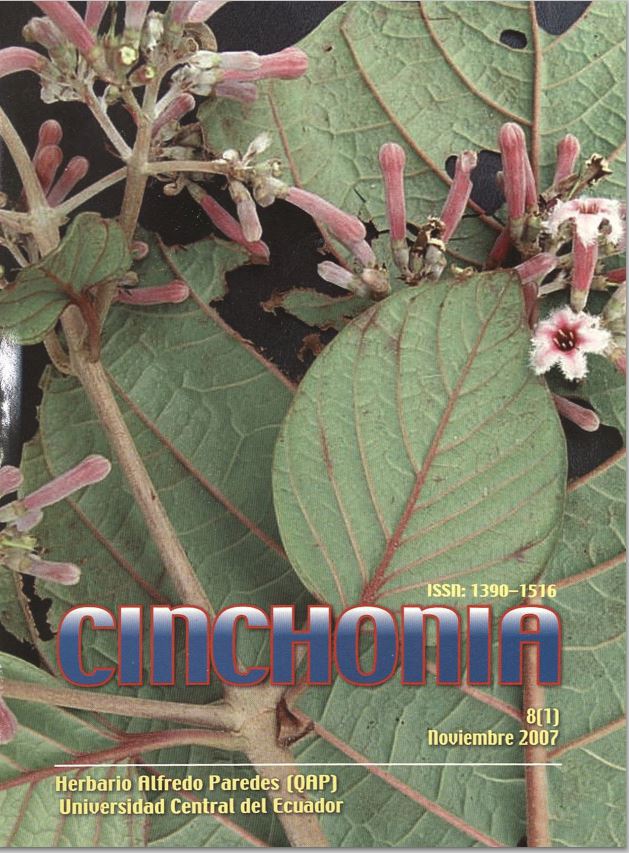COMPOSICIÓN Y ESTRUCTURA FLORÍSTICA EN UN REMANENTE DEL RÍO PACHIJAL, PICHINCHA - ECUADOR
Main Article Content
Abstract
The basin of the river Pachijal is located in the counterfort of the Western Mountain range of the Andes, it embraces a range altitudinal from 1.300 to 1.700 msnm, it corresponds to the vegetable formations: Forest siempreverde iow montano and Forest of fog montano. The field work was carried out from April from 1999 to July of the 2000, in the right riverbank of the river Pachijal, property of the Mr. Galo Buitrón. A permanent parcel of 2 hectares settled down, of 20 x 1.000 m. all the individuáis were collected to 5 cm of DAP, to each one an aluminium badge was placed numbered from now on from 1. A copy is mounted and identified in the herbarium Alfredo Paredes (QAP) of the Central University of the Ecuador. In the field he/she registered the height and the diameter, with that which you proceeded to calcúlate the Basal Area and the Index of Valué of Importance (IVI), of the species, goods and families. It was also analyzed the changes that take place in the according vegetation the gradient altitudinal it advances. He/she registered 2.596 individuáis, corresponding to 185 species, 104 goods and 49 families. 13.75% was in fertile State. The Area Basal total is 70.13 m2. The most frequent species are: Palicourea demissa, Ossaea micrantha, Faramea oblongifolia, Matisia malacocalyx, Persea rigens, Ocotea stenoneura, Meriania finicola, Coussapoa contorta, Miconia “alba”, Ocotea floccifera, Miconia cf. intrincata, Conostegia centronioides, Tovomita nicaragüenses and Helicostylis tovarensis. According to the IVI, the most ¡mportant are: Palicourea demissa, Coussapoa contorta Alchomea triplinervia, Ossaea micrantha, Persea rigens, Matisia malacocalyx, Elaeagia utilis, Faramea oblongifolia, Ocotea stenoneura and Endlicheria formosa. The frequent goods are: Palicourea, Ossaea, Ocotea, Miconia, Faramea, Matisia, Persea, Meriania, Myrcia and Cyathea. According to the IVI, the most ¡mportant are: Palicourea, Ocotea, Coussapoa, Ossaea, Ficus, Myrcia, Persea, Faramea, Matisia and Eugenia. The most frequent families are: Rubiaceae, Melastomataceae, Lauraceae, Moraceae, Bombacaceae, Myrtaceae, Cyatheaceae, Cecropiaceae, Clusiaceae and Chloranthaceae. According to the IVI, the most ¡mportant are: Rubiaceae, Melastomataceae, Cecropiaceae, Myrtaceae, Moraceae, Bombacaceae, Clusiaceae, Chloranthaceae and Cyatheaceae. The canopy, located between 20 and 35 m of height, contains 237 individuáis (9.11%). The presence of lianas, they constitute 38 species (1.46%; 0.42 m2 of Basal Area). The emergent trees reach until 40 m of height. The subdosel located between 6 and 19 m, it is constituted of 1659 trees (63.91%). The sotobosque, located between 1 and 5 m, this conformed of 662 small trees (25.50%). They can be new species for the Science, twelve plants of the goods Cyathea, Hasseltia, Ocotea, Rhodostemonodaphne, Eschweilera, Lecytis, Miconia, Ossaea, Eugenia (sp.1 and sp. 2), Myrcia and Meliosma. The results, indícate that in the area variation of type altitudinal exists, it is advisable the realization of permanent pareéis at different 86 Cevallos et al.: Composición y Estructura, Pachijal levels, with the purpose of detecting the m¡- crohábitats variation expressed in changes of diversity, structures and composition

